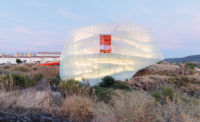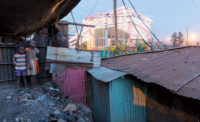El B Auditorium and Congress Hall by SelgasCano
Cartagena, Spain

"“El B” appears blue (foreground in photo).

A polygonal cutout in the polycarbonate wall of the foyer serves as an information window. Outside, selgascano treated El B’s roof as a fifth facade: Multicolored alumnium sheets provide a continuous surface.

On the south facade, rows of LEDs placed at the base of the methacrylate walls create an illuminated backdrop.

Seen from the southwestern corner, “El B,” the name the architects prefer for the building, is rendered in orange.
Photo © Roland Halbe

The metal scaffolding that supports the methacrylate facade—and the longitudinal line of LEDs at its base—is clearly visible beside the box office window.

As visitors make their way through the building, they are gradually submerged below the level of the pier, which is marked by the horizontal line that divides the upper methacrylate and the lower concrete retaining walls. The orange ETFE plastic sidelight looms above this space, allowing ample light into the building.

The expansive foyer leads to the main auditorium. Steel staircases—with rubber-lined treads and polycarbonate balustrades—connect the building’s different levels to the auditorium and contrast with the rough concrete of the walls.

A sinuous ramp (background in photo) runs the length of El B and is accompanied by colorful benches in irregular shapes. The second-level landing of the steel stair offers an oblique view of the double-layer, pressurized ETFE plastic sidelight that spans the building’s entire width (92 feet).

The orange ramp descends from the second level to the first, connecting the exhibition room with the foyer. Eero Aarnio’s plastic bubble chairs hang from the suspended walkway.

The aquatic blue-green of the 1,500-seat auditorium’s polycarbonate walls provides a chromatic contrast to the space’s orange skylight.

A mirrorlike screen behind these walls multiplies and refracts the light.

Image courtesy Selgascano

Image courtesy Selgascano

Image courtesy Selgascano

Image courtesy Selgascano

Image courtesy Selgascano
















Architects & Firms
Cartagena, Spain, has a long, rich history, beginning even before it became an important western Mediterranean port during the Roman Empire. With a natural harbor, it served as a naval base for centuries, its ramparts dating back to the eighteenth-century reign of Charles III. Now the city is reinventing itself as a cultural tourism destination—as shown by the construction of a museum by José Rafael Moneo, that celebrates the city's ancient Roman amphitheater and more recently by the opening of the exuberant new El B auditorium and congress hall, designed by the Madrid-based firm SelgasCano.
Running along the Paseo Alfonso XII, a 3,300-foot-long dock overlooking the Mediterranean, the 690-foot-long building echoes the stacked shipping containers on the neighboring wharfs. Its innovative use of plastic responds to a tight budget yet gives the light, flat-looking cladding over a steel-frame and poured-in-place concrete structure a surprising luminosity. The effect is soft and shimmering, like movement captured by a photograph taken with a long exposure. The roofline, interrupted by vertical cuts that introduce daylight into the interior, adds drama to the building's silhouette. Syncopated variations in color, light, and reflection make the segmented structure distinctive but still blend in with its watery surroundings and the historic city walls behind it.
José Selgas and Lucía Cano, who both graduated from Madrid's Polytechnic School of Architecture in 1992, are well known for their research into materials: With their Badajoz Conference Center, they explored polycarbonate's translucency and acoustic properties, employing standardized panels. In Cartagena, they have taken their investigation a step further, designing asymmetrical, custom-made extrusions in two different plastics, in order to introduce color into the cladding. Pedestrians and joggers on the dock become engaged in the exterior's bright surfaces, which shift and change according to the observer's vantage point—a polychromatic exercise intensified in the hall's interiors.
To achieve the vibrant, colorful surfaces, the architects used transparent methacrylate (with UV protection) for the exterior facades, and transparent and translucent polycarbonate (which is fire resistant) for the interiors. Both plastic materials are mounted on the structure by stainless steel hooklike extrusions. The transparent methacrylate of the elongated facades is double-layered yet admits daylight into the building. On portions of the exterior walls of the auditorium proper and the stage house, the architects laid polycarbonate tubes in an irregular profile of three layers (see section detail, page 61) to underscore the building's horizontal linearity with flecks of color. Inside, walls of transparent aquatic blue-green polycarbonate, backed by a silver mirrorlike screen, enclose the 1,500-seat concert hall. Opal white polycarbonate, backlit, wraps the 500-seat auditorium, covers the ceilings of both auditorums, and clads the conference room walls.
As if this exploration of plastics were not enough, SelgasCano inserted a 92-by-40-foot double-layer pressurized ETFE (ethylene tetrafluoroethylene) plastic sidelight in the building's main foyer. The expansive sidelight's two surfaces are stiffened by vertical cables and anchored to a simple rectangular steel frame to create the largest ETFE single cushion ever made. Its orange color and western orientation create the illusion of an endless sunset in the only vertical space interrupting this longitudinal structure; from this multilevel foyer, stairs take you to different levels of access into the stunning watery blue concert hall. A second smaller ETFE plastic sidelight, oriented to the east, casts a warm glow over the VIP lounge on the second floor.
Multicolored aluminum sheets of angular fins cloak the end walls; on the west wall, at the main entrance, the Spanish graffiti artist SpY created a series of overlapping gigantic letters (“El-B”—the name of the auditorium)that shifts from blue to orange as you move past it. Once you enter the building through this short end, a long promenade–which recalls the old ramp to El Batel Beach—takes you down to the main hall, built 49 feet below grade to minimize the height of the exterior volume. You can also climb a sinuous ramp up to the exhibition space on the second floor, or to the restaurant or open-air café.
The building's opposing qualities create an interesting spatial tension: An exterior that is an abstract volume, like the nearby generic dockside structures, is juxtaposed with a playful interior, where the architects manipulated the horizontal and vertical spaces to animate the longitudinal section. The long facades produced by this radical design strategy may, at first glance, appear too closed to activate an underused area of the city. But closer observation reveals the opposite. By varying color and layout, the architects achieved an infinite array of light-reflection effects that enhance the visitor's experience. From one perspective, you see the lines of different colors clearly; then they disappear, and the building seems transparent.
Throughout El B, the overall effect of frozen light, of extreme silence and calm, makes you feel as if you were inhabiting a space outside time. Yet you never feel isolated: Whether you are walking in solitude around the building or passing through it, the materials envelop you like a cloak. El B shows how a daring architectural proposal, using an economy of means, can enhance this latest chapter of Cartagena's rich history, sounding a bright and hopeful note in an uncertain time.
Laura Martínez de Guereñu is a Madrid-based architect and critic.
Behind the Plastic: Assembling the Shimmering Facade
 |
| Photo © Roland Halbe (top right); Denis Gilbert (bottom) |
| A latticelike steel support structure holds the south and north facades’ methacrylate components (top) in place. It is anchored by a system of stainless steel clamps (bottom). |
The exterior walls of methacrylate block UV radiation and yet gleam in the sunlight, thanks to the extruded profile of longitudinal strips. While plastic seems to be cheap and flimsy, with a short life span, the architects argue it will last at least 20 years. The strips are applied like clapboard to the metal armature of exterior walls (right, top and bottom), emphasizing the horizontality of the volumes along the north and south facades.
In order to add variation to the rippling luminosity of the surface, two different asymmetrical components with a slight difference in their curvature are used. The metal framing that holds the double-layer methacrylate facade is revealed at the building’s main entrance through its west short end, following the architect’s explicit effort to show how the building is assembled.
The exterior walls of the stage house and the upper part of the auditorium are opaque and formed of horizontal polycarbonate tubes (section detail, right). Mounted to simple washers on a steel substructure, they create a dense, undulating surface.
The architects argue that the plastic is not only economical ($20 per square foot) but sustainable, since it is 99 percent recyclable, while only 50 percent of the glass can be recycled. While the basic colors in El B range from transparent (no color) for the methacrylate to opal white and green blue for the interior polycarbonate, other colors are interjected to add orange, yellow, and green lines to the palette. The process involves tinting melted plastic, then injecting it by hose into the molds of the profiles. The range of hues camouflage the dust and sand that often streak the facades of other buildings.
Completion date: November 2011
Size: 200,000 square feet
Cost: $45 million
Architect and Site Design:
SelgasCano
Guecho 27-SC
Madrid 28023
Spain
PeopleLocation: CARTAGENA, SPAIN Site of the building: PASEO DE ALFONSO XII SN 30202 CARTAGENA Owner: CARTAGENA COUNCIL Date Project Completed: NOVEMBER 2011 Design Phase: 2002-2004 Construction Phase: 2006 - 2011 Total Square Footage: 18.500 m2 Number of Floor Levels: 2 Budget: 34.5 euro millions Architect and Site Design Project Architect: Jose Selgas, Lucia Cano PhotograPher: Interior Design Firm: SelgasCano Architectural Assistant: Antonio Mármol, Joaquín Cárceles, Rául Jiménez. Engineers Mechanical, Electrical, Plumbing (MEP) Engineer: JG Acoustic Engineer: ARAU ACUSTICA Textil Arquitectures: LASTRA Y ZORRILLA General Contractor: INTERSA Other Auditorium seatting: FIGUERAS Floors manufacturer: PRIALPAS Lighting manufacturers: IDEALUX Lighting manufacturers: TALLERES ZAMORA Wall manufacturers: ATA AISLAMIENTOS TECNICOS AGROALIMENTARIOS |
ProductsPlastic: Polimer Tecnic Seating: Figueras (auditorium) Flooring: Prialpas Lighting: Ideallux; Talleres Zamora |



















